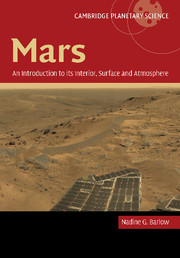Book contents
- Frontmatter
- Contents
- Preface
- 1 Introduction to Mars
- 2 Formation of Mars and early planetary evolution
- 3 Geophysical measurements and inferred interior structure
- 4 Surface characteristics
- 5 Geology
- 6 Atmospheric conditions and evolution
- 7 History of water on Mars
- 8 Search for life
- 9 Looking ahead
- References
- Appendix: Mission reports
- Index
- Plate section
2 - Formation of Mars and early planetary evolution
Published online by Cambridge University Press: 15 December 2009
- Frontmatter
- Contents
- Preface
- 1 Introduction to Mars
- 2 Formation of Mars and early planetary evolution
- 3 Geophysical measurements and inferred interior structure
- 4 Surface characteristics
- 5 Geology
- 6 Atmospheric conditions and evolution
- 7 History of water on Mars
- 8 Search for life
- 9 Looking ahead
- References
- Appendix: Mission reports
- Index
- Plate section
Summary
Formation of Mars
Accretion
Mars, along with the rest of the Solar System, formed ∼4.5 × 109 years (109 years = 1 Ga) ago out of a cloud of gas and dust called the solar or protoplanetary nebula. The direction of orbital and rotational motions for Mars and most of the other planets and moons indicates that this nebula was slowly rotating in a counterclockwise direction as seen from above the ecliptic plane. The cloud underwent gravitational collapse when it was perturbed by an external event, possibly the explosion of a nearby star, interaction with galactic molecular clouds, or passage through a spiral density wave. Because of the cloud's initial spin motion, the cloud collapsed to a flattened disk with a central bulge. Collapse of the central bulge produced the Sun.
The formation of Mars and the other terrestrial planets is typically divided into three stages: formation of kilometer-sized planetesimals, formation of planetary embryos, and collisional formation of larger planets (Canup and Agnor, 2000; Chambers, 2004). Rotational motion within the flattened disk caused small dust grains (∼1–30 micrometers [μm] diameter) to collide and stick together, building up larger objects (Weidenschilling and Cuzzi, 1993), although gravitational instabilities causing fragmentation of the cloud into clumps might also have contributed (Ward, 2000; Youdin and Shu, 2002; Chambers, 2004). Gas drag and gravity cause these increasingly larger and more massive particles to settle towards the disk's midplane, explaining why the planetary orbits are approximately coincident with the ecliptic plane.
- Type
- Chapter
- Information
- Publisher: Cambridge University PressPrint publication year: 2008



